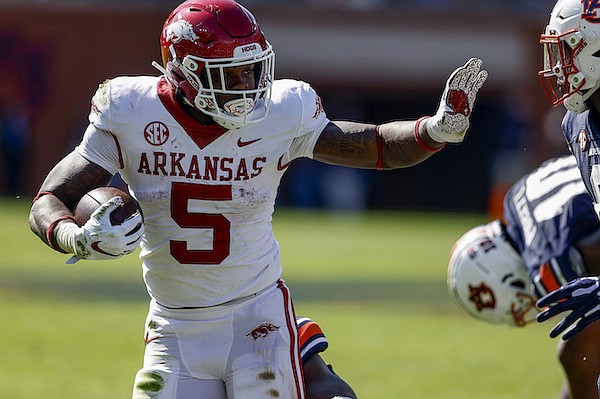Despite the forward-looking title, almost all of this post is more comprehensive review of the offense against Western Carolina in Dan Enos’s first game (back) as the Razorback offensive coordinator. We’re breaking down formations and playcalls and answering the big question about the offensive transition.
Final look at Western Carolina
Thanks to play charting from SEC Stat Cat, we can get a deeper look at the Western Carolina game, especially in terms of formations and play calls in Enos’s first game as offensive coordinator.
Rocket regression?
After leading the SEC in explosive runs over the last two years under Kendal Briles, the Hogs had just two explosive runs in this game. That’s a transition Hog fans need to prepare for. We warned last week that Rocket Sanders might be due for a regression because of his reliance on the huge holes that the Briles run scheme provided. Sanders led the SEC in yards before contact last year, but he was below-average at generating yards after contact.
How did Briles’s scheme produce such big holes, and why can’t Enos just do what Briles was doing? It’s complicated, but Briles’s RPO-heavy scheme largely invites the defense to be aggressive, because a well-executed RPO can really only be stopped by pressuring the exchange. That means a lot of offensive plays get blown up, but if the defense guesses wrong, a huge play can result.
Enos was late to the RPO game, and he didn’t use them during his first go-round in Fayetteville. However, at Alabama in 2018, he adopted much of the “Spread Coast” scheme implemented by Lane Kiffin… the same scheme that Briles learned from Kiffin at FAU that same year. Schematically, Enos and Briles are now very similar, with the main difference being that Enos is less risky and more quarterback-focused (and thus more pro-style). Enos, then, will call fewer RPOs. But he’ll still use them, and against Western Carolina, they worked really well:

On the 11 RPOs, the Hogs were 7 of 7 for 129 yards and a touchdown through the air, with four rushes for 18 yards and a touchdown. Three of the rushes were gap scheme runs, and they gained 29 yards. The lone zone RPO was blown up for an 11-yard loss.
If the Hogs continue to have high success with RPOs, then opponents will have to blitz more, which will open the door to more explosive runs, just as it did for the Briles offense. So I’m not ready to say that Arkansas isn’t going to be able to run the ball this year or that Sanders is going to have a bad season. Enos and Sam Pittman will have to figure out what level of risk they are okay with, and the numbers of RPOs will go from there. I would expect that the RPO counts will remain low against Kent State.
- What Arkansas is getting in Nick Pringle and Malique Ewin

- Box Score Breakdown: Texas Tech 85, Arkansas 83
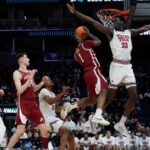
- Matchup Analysis: 3 Texas Tech

Formations
Here’s how Arkansas’ formations broke down in the game:

The Hogs used a lot more looks with 12 personnel (two tight ends), as you’d expect from Enos. Here’s a Pistol look with twins right and twin TE left that we didn’t see last year. The off tight end motions across the formation to set up a Waggle from play action:
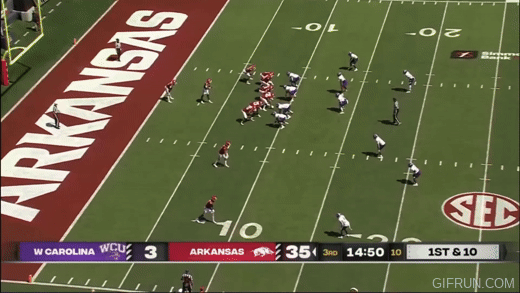
More than half of Arkansas’ total plays were from “Ace”, which I’m calling any 11 personnel look that is 2×2: twin receivers to one side, and a tight end plus flanker on the other. There are all kinds of variations: the twin receivers can be stacked or pulled in close to the line, and flanker can be close, the tight end can be in a wing position (off the line, so the flanker is on the line), but all of those are grouped under the name “Ace”.
Run Game

Briles favored zone over gap, but the Hogs were more balanced in this one. The “special run” listed here was a quarterback sneak.
The zone runs did produce both of Rocket Sanders’ touchdowns at the goal line, but they generated zero explosive runs and just 2.9 yards per rush in 18 tries. Not great.

While Briles often tried to establish outside zone last year as a base (the Hogs were quite bad at OZ), Enos didn’t really bother in this game, preferring to run straight between the tackles from the beginning. They had already called two power runs and two inside zones before the first outside zone of the game.
The “Inside Power Read” is just a Counter Read, which the Hogs ran plenty of last year. There are several kinds of Counter Reads – we looked into the variety that the Hogs used last year in this post – but for this game we saw four G Counters and two GT Counters. Only two Counters were run in the first half. We also saw two Duo Jabs and one Power (like a Counter, but run to the tight end side), all in the second half.
The “Outside Power Read” set is a bit more interesting, because we saw four Pin/Pull Base runs, which will likely become a staple of this run game. This was basically absent from the Briles run game, because it’s more of an old-school Power run. It’s an outside run over the tight end with backside linemen pulling:
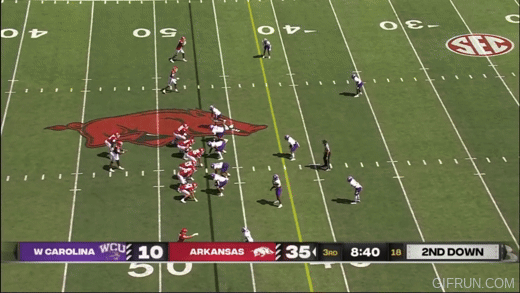
That was Rocket’s only explosive carry of the game. The Hogs ran this one four times for 24 yards and two successes.
We also saw a zone toss to AJ Green, which gained nine yards. The four off-tackle zone runs gained a combined one yard. The Hogs tried two Power Veers (the Cam Newton run where KJ can hand off on an outside run or keep and run up the middle), but one of them was ruined by a bad snap. We did not see any Bash concepts, which Briles used as an outside power run last season. I would guess than the Base run has replace those for Enos.
Pass Game

Everything worked in the passing game. On true dropbacks, Jefferson was 4 of 6 for 86 yards, one touchdown, and one sack. On play action, Jefferson started 3 of 3 for 57 yards and a touchdown, then was incomplete on his final three tries. Jacolby Criswell threw a touchdown on his lone play action attempt.
The Screen & RPO passing game was more of a mixed bag. The two QBs (Jefferson 11, Criswell 1) combined to go 12 for 12 on these. On RPO outlets, Jefferson was 6 of 6 for 115 yards and his first touchdown to Jaedon Wilson. That 65-yard touchdown was a Bubble screen, but the next two RPO Bubble concepts only gained minus-3 and 4 yards. Two Tosser (slant) concepts worked for 13 and 10, and a Smash concept on an RPO worked for 20. The five non-RPO screens went for a combined 11 yards and none of them were successful. Let’s do the math: take out the touchdown, and the other seven screen passes went for a combined 15 yards, with no gain longer than five.
So the takeaway is that Arkansas’ pass-catchers did a great job of getting open and completing the catch (there were no drops), but they were not able to break many tackles at all.
This, for example, could have gone better:
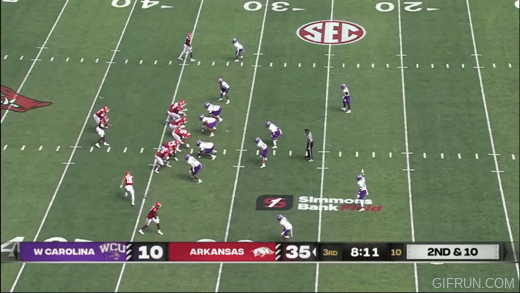
Here’s the full concepts list:

Jefferson looked strong overall, posting a 56% depth-adjusted accuracy, which is a good bit higher than his last year average. Every attempt that traveled less than 15 yards from the line of scrimmage was complete, and he was 15 of 16 on throws with less than 20 air-yards.
On downfield throws, his footwork, mechanics, and accuracy were good, and he had a clean pocket all game. He reads the middle of the field very well, and none of his passes were graded as “interceptible”.
Here’s Dagger, a two-man concept where the inside receiver (tight end Luke Hasz) runs a deep vertical route to occupy the safety, allowing the outside receiver (Isaac TeSlaa) to run a deep square-in and come open underneath him:
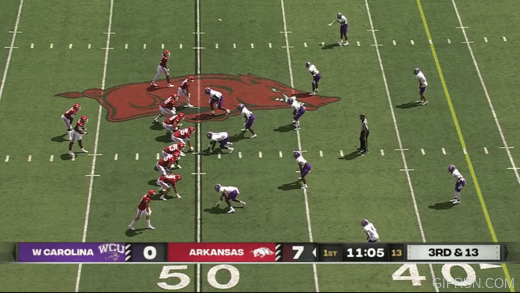
The Mills concept (a Petrino staple) is a similar throw, but the read is the inverse. Here, the inside receiver runs a square-in that occupies the safety so the outside receiver (Andrew Armstrong) can run a post over the top:
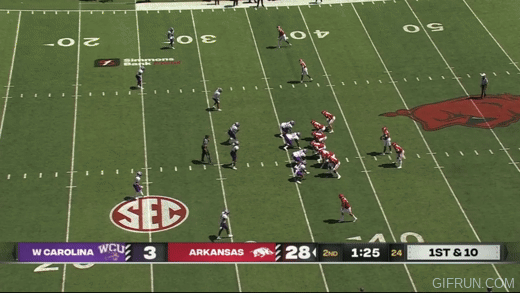
Jefferson looks extremely comfortable on these throws. He had good footwork and delivering extremely accurate passes on both the Mills and Dagger.
There’s still plenty to work on. This Switch (Scissors) concept was wide open for Armstrong, and Jefferson misses it pretty badly, despite it being an identical throw to the Mills above:
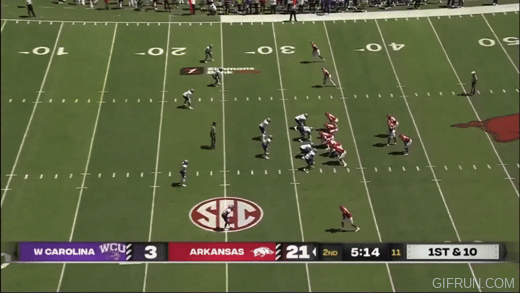
Jefferson also missed a few reads. On this Smash, Jefferson misses his chance to hit the underneath quick out for a first down, so the throw to the deeper target (Isaiah Sategna) is late and broken up:
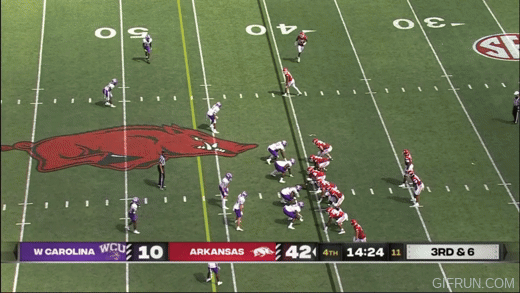
Given the protection and pass-catching ability of the receivers, it’s safe to say that the Hogs could have done a lot more damage down the field had they wanted. At some point, they’re going to have to punish an opponent down the field in order to win.
Looking to Kent State
Kent State might be the worst FBS program this season. Their football program has little institutional buy-in, so they have no hope of landing major recruits or keeping good players or coaches. Promising head coach Sean Lewis left to take the Colorado OC job this offseason, so the Golden Flashes promoted assistant Kenni Burns to the head job. They were immediately drained by an exodus of key performers from last year’s 5-7 team.
In Week 1, the Golden Flashes lost 56-6 to UCF, surrendering more than 700 yards to Gus Malzahn’s Golden Knights. Basically nothing went well for Kent State on either side of the ball, and there are no positive takeaways.
I would expect the Hogs to lean on the run game a bit more. Kent State allowed UCF to rush for nearly 400 yards, and the Hog backfield would probably like some confidence after struggling against WCU. Even if Rocket Sanders is indeed out – he’s nursing a hopefully-minor knee issue – the Razorbacks should have no issue moving the ball on the ground.
Defensively, UCF didn’t blitz much, as it was unnecessary. Kent had a dismal 55% leverage rate and couldn’t buy a big play. I would expect something very vanilla on defense.
Thanks for reading! Be sure to follow us on Twitter and on Facebook.
The latest from Fayette Villains, straight to your inbox
Enter your email to subscribe and receive new post alerts and other updates. You can unsubscribe at any time.
